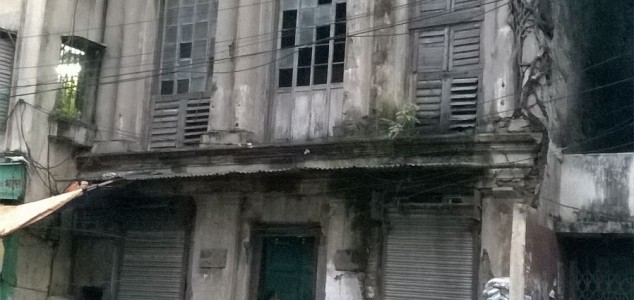
Signpost of Bengal Renaissance Stands in Ruin
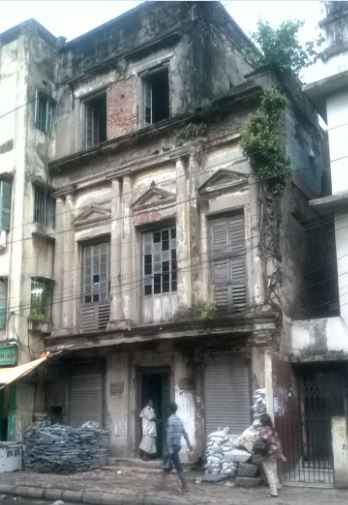
First Prayer Hall of Brahmo Samaj at Chitpur Road (Rabindra Sarani) Kolkata. Hundreds pass by this building situated on the busy Rabindra Sarani,  unkown to them is this buildings legacy. Photo: www.probashionline.com
Editors Note: This is the Adi Brahmo Samaj church on Chitpur Road (Rabindra Sarani), close to Jorasanko Thakurbari, Kolkata. This is the  first prayer house of the Brahmo Samaj and was inaugurated by Raja Ram Mohan Roy in 1830. We at probashionline.com decided to visit this 185 year old forgotten and crumbling structure which is an important monument of the Bengal Renaissance.
This prayer hall in many ways cradled the then nascent Bengal Renaissance movement and was witness to debates , speeches and resolutions  which changed the the social firamament of India.  Brahmo Samaj gave to the nation the pall bearers of the Renaissance movement- men and women who heraleded the Modern India, and a part of that  process  started in this very building. Â
In its days of yore this structure has seen  luminaries of the Bengal Renaissance walk through her doors including Dwarkanath Tagore, Debendranath Tagore, Keshab Chnadra Sen, Rabindranath Tagore , Ishwar Chandra Vidyasagar (who was secretary of Brahmo Samaj for a short while) , Akshay Kumar Dutta etc. The first strains of Tagore’s Brahma Sangeet were heard in this building, sung by the poet himself . It is also quite likely that Vivekananda , who was a friend and class mate of Deependranath Tagore, one of the nephews of Rabindranath and a frequent visitor to the Tagore family house at Jorasankho during his college days did step into this prayer hall. Vivekananda  was attracted to the Brahmo movement during his college days.
The structure is in very poor state of maintenance and we fear that  in the  coming years might disappear from Kolkata cityscape.  The probashionline.com team had a difficult time locating this building. Armed with the address 55, Upper Chitpur Road ( near Jorasankho Thakur Bari), the team was informed by the locals that the road has been renamed Rabindra Sarani and the address listings have changed. The numerous people we enquired from had no knowledge of the first Brahmo Prayer Hall. One bystander however told us of his vague recollection of such a structure near Ganesh Talkies. A tram ride from the Lower Chitpur Road junction towards Ganesh Talkies and  a chance sighting from the slow moving tram of the board informing of the Adi Brahmo Samaj Prayer hall took us to this structure.Â
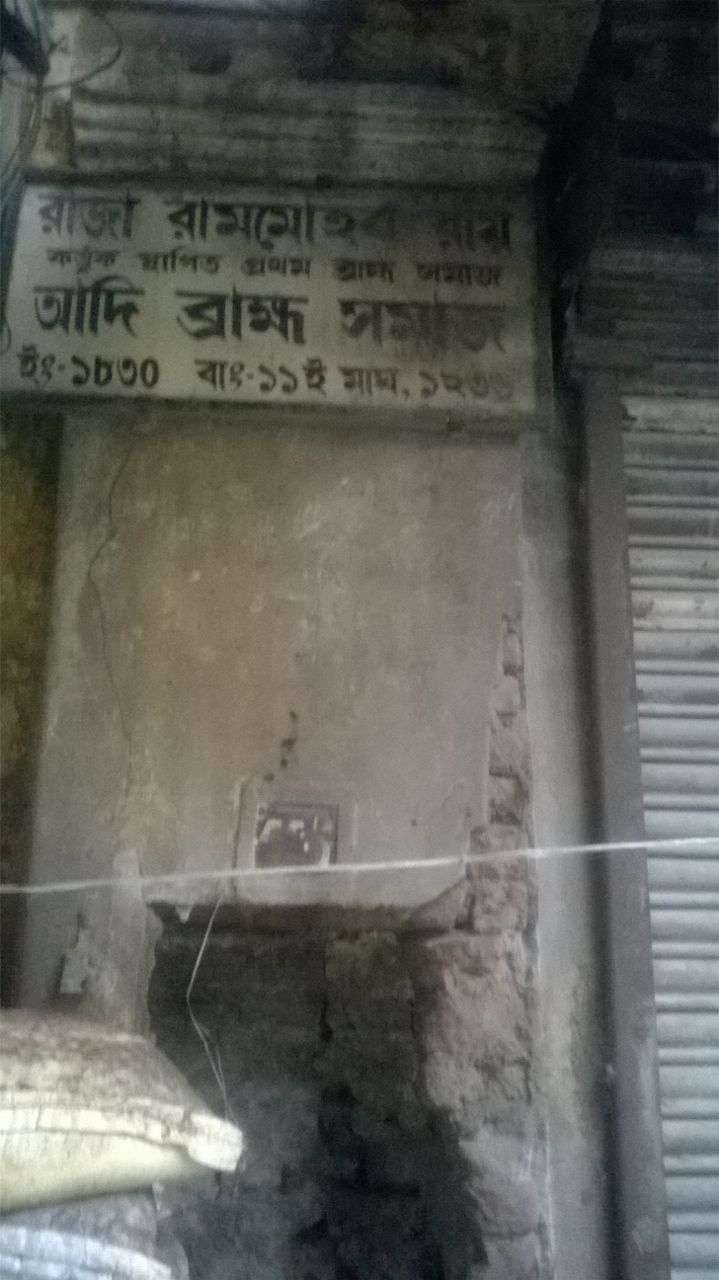
The Board which reveals the identiy of this builidng. Tucked above piles of marble bags, and shadowed by a canopy, the signage is not visible unless you are looking for it. Photo: www.probashionline.com
The Brahmo Sabha (The One God Society and percusor  of the Brahma Samaj) congregations was started in 1828 by Raja Ram Mohan Roy at Firengi Kamal Basu’s house at 50 Upper Chitpur Road( incidentally from  this house Scottish Church College also started operations), and in 1830 shifted to this building at 236, Rabindra Sarani (55, Upper Chitpur Road) .
This house was bought through a donation made by Dwarkanath Tagore, grandfather of the poet Rabindranath Tagore. On 23 January 1830 , this prayer hall was publicly inaugurated by Raja Ram Mohan Roy. In attendance were more than 500 elite Bengalies of Kolkata and atleast one English gentleman William Adam, an Unitarian and friend of Roy. This day is celebrated by Brahm Samajists as Maghotsab (মাঘোৎসব Maghotshôb “Magh celebration”).
A trust deed (dated 1830) was executed for transfer of the Chitpur Road prayer hall to the Trustees of the Brahmo Sabha. This trust deed is not just a legal document , it underlines Ram Mohan Roy’s thought on the basic precepts of the Brahmo religion. This trust deed thus became the guiding framework of the Brahmo Samaj, some of whose  aadherents  in the coming years were to change the course of modern Indian history. Those interested may refer to the original trust deed of this property at (http://www.thebrahmosamaj.net /samajes/trustdeed.html).
Soon after the inauguration of this prayer hall Ram Mohan Roy left for England where he died. The Brahmo Sabha which had the Calcutta elite as its patrons started to lose steam. Many of the adherents who were attracted by the charisma of Ram Mohan Roy slowly melted away. Two individuals- Dwarkanath Tagore and Ram Chandra Vidyabagish (both of them were the Trustees of the Samaj/Sabha ) kept Ram Mohan Roy’s legacy alive. Dwarkanath provided the money for the upkeep of this prayer hall and Vidyabagish managed the operations. Weekly service was held, originally every Saturday evening; later it was transferred to Wednesday. It consisted of three successive parts, viz. recitation of the Vedas by Telegu Brahmins in the closed apartment exclusively before the Brahmin members of the congregation, reading and exposition of the Upanishads for the general audience, and singing of religious hymns.
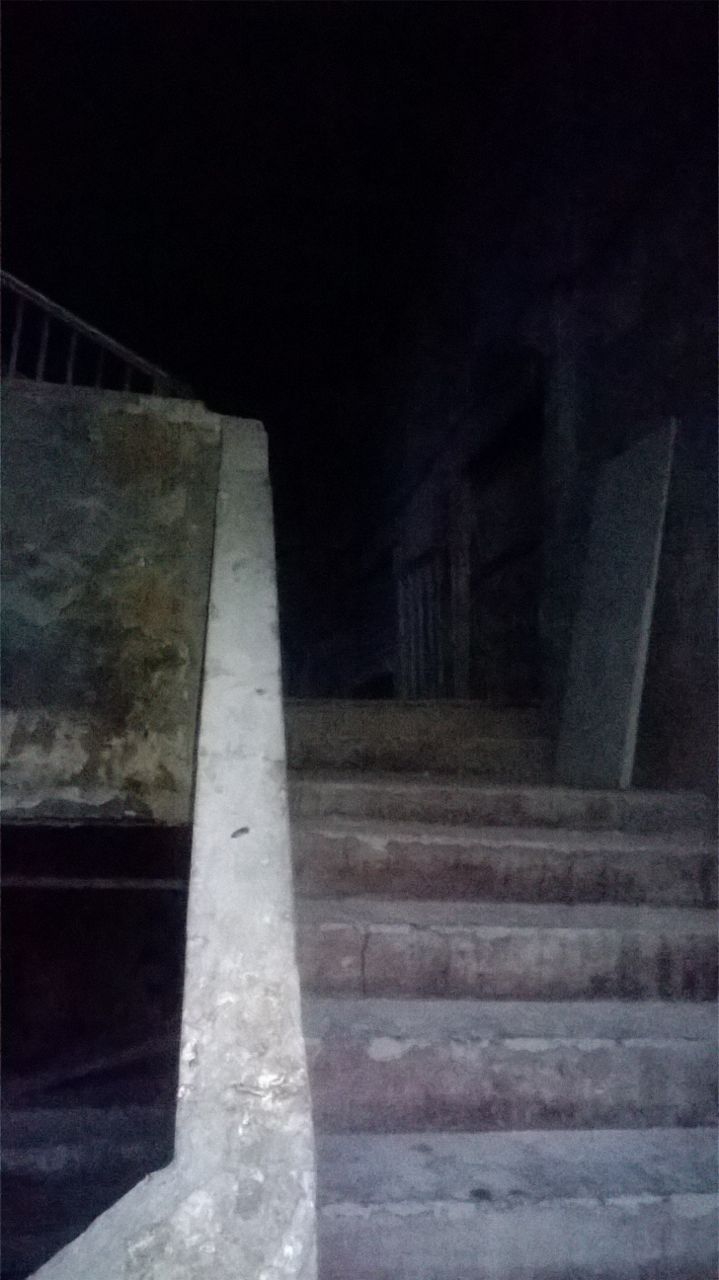
The  wooden staircase leading to the main prayer hall on the first floor. These stairs were once climbed by the best and the brightest of Bengal. Photo: www. probashionline.com
It was Debendranath Tagore , father of the poet Rabindranath Tagore, who revived the Brahmo Sabha when he joined the Sabha in 1843. Debendranath codified the Brahmo tenents and positioned Brahmo Sabha as Brahmo Samaj , a religious order. The Chitpur Prayer hall came also to be refered to as the seat of the Calcutta Brahmo Samaj. As Brahmo Samaj gathered momentum under Debendranath Tagore, the Chitpur prayer hall saw its golden days, with some of the luminaries of the Bengal Renaissance frequenting this building.
However with the breakup of the Brahmo Samaj in 1866  a large body of the Samajists under Keshab Chandra Sen set up an alternate prayer hall at present Keshab Chandra Street . The breakaway group called itself the Brahmo Samaj of India. The original faction renamed itself as the Adi Brahmo Samaj and the Chitpur road prayer hall came to be known as the Adi Brahmo Samaj church. Following this schism, the followers of the Adi Brahmo Samaj began to dwindle, the Chitpur prayer hall began to slowly lose patronage.
The prayer hall now is in a dilapidated condition and stands on Rabindra Sarani in anonoymity.  Located at a stone throw distance from the rear entrance of Jorasankho Thkurbari and opposite to Sree Didoo Panchayat Vidyalaya, for the curious this house is not difficult to locate. Sadly the locals as well as most Calcuttans have forgotten the legacy which this prayer hall started.
Currently the ground floor of the prayer hall is occupied by a marble trader . The caretaker allowed the  probashionline.com team  to enter the house . The ground floor is a godown of marble slabs and chips, rows of which can be seen stacked on the ground floor hall. There were also marble chips staked on either side of the entrance  on the pavement outside the building. The first floor is occupied by labourers working for the marble trading company. Here they cook and sleep. We even saw a dog peering at us as we made our way up the wooden staircase. The main prayer hall was found locked.
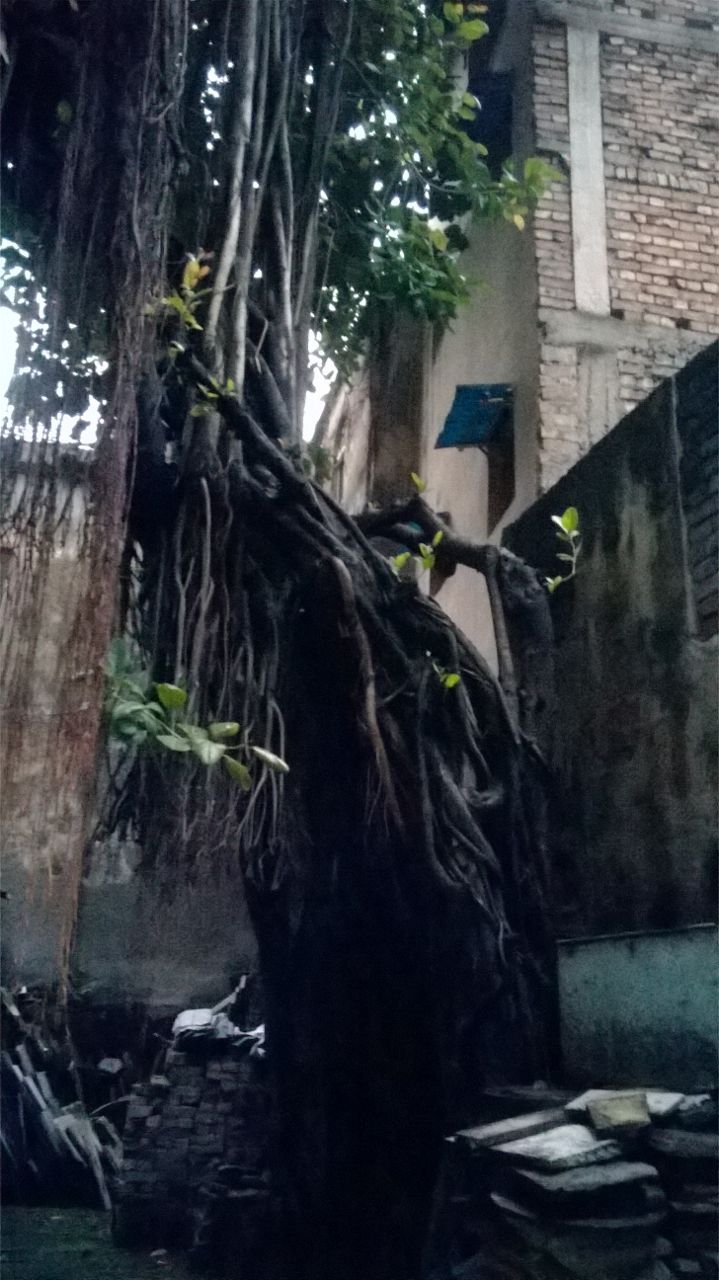
The old Baniyan tree in the rear courtyard of the prayer hall building. This tree has been witness to history being created. Photo: www.probashionline.com
The caretaker informed that his father started to work for the marble trading company and he followed his father. The Brahmo Mandir is his home and so was it for his father.  The building is in urgent need for repairs, though in the first floor we did see some new plastering and a slapshod coat of paint. On the exterior, plaster of the building is giving way and the skylights have broken glass panes.
According to the caretaker  till two years back Adi Brahmo Samaj prayer sessions were held here, which since then have ceased. With dwindling in the numbers of the Adi Brahmo Samaj adherents, the buidling is facing increasing neglect. Ironically this building  features in the list of heritage buildings of the Kolkata Municipal Corporation and is to be preserved.
From here started the Brahmo  movement which gave India extraordinary men and women who changed Indian history. The building in turn is asking for an extrordinary effort to keep the Brahmo legacy standing.
Some extrordinary Brahmo Samajists: Ananda Mohan Bose (first Indian to qualify Cambridge Mathematics Tripos and founder of City College), Acharya Jagadish Chandra Bose (scientist), Ramanand Chatterjee (father of Indian Journalism), Pratap Chandra Moozomdar (philospher of global renown), Bipin Chandra Pal (freedom fighter), Acharya Prafulla Chandra Ray (founder of Bengal Chemicals), PK Roy (Fellow London University-Philosophy), Dr Brajendranath Seal (philosopher and first VC of Visva Bharati University), SP Sinha (first Indian Advocate General of Bengal ), Nilratan Sircar (famous medical practitioner), Rabindranath Tagore (Nobel Laureate), Chittaranjan Das (jurist and freedom fighter), Bidhan Chandra Roy (Chief Minister of West Bengal) , PC Mahalanobis (founder of Indian Statistical Institute), Satyajit Ray ( Film Director), Kadambani Ganguly ( first women graduate in India) and many more…


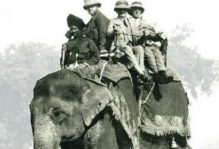

It’s a shame that we so easily forget our glorious past. Moreover, Government is also reluctant about restoring the historical monuments. Something must be done to preserve this building
We must save this building at any cost. The best and the brightest of Bengal Renaissance walked into this buiding. Please suggest how we can support.
I think there probashionline.com can think of organising a body - like a trust - that would try and preserve the heritage of the country that has been left behind but never forgotten. Members would try and talk with politicians and decision-makers; raise money, garner public support and do whatever is necessary to preserve the built heritage of cities like Calcutta which are like museums of a past glory.
I would be happy to be a part of such an initiative, as I had suggested earlier.
onice and great article